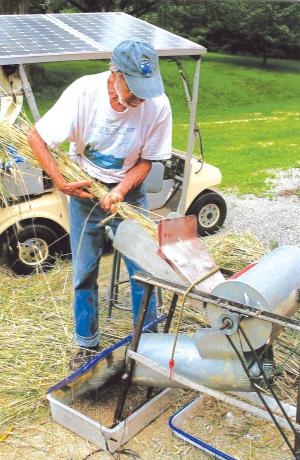2024 - Volume #48, Issue #5, Page #29
[ Sample Stories From This Issue | List of All Stories In This Issue | Print this story
| Read this issue]
Mini Thresher Lives On Through Plans
 |
Howe built his first prototype around 35 years ago and fine-tuned the design for decades as interest in local food production grew. Howe successfully sold across the country for years. He priced the thresher at $575, which included a 1/3-hp. motor, as he warned buyers not to fall for the claims of bicycle or treadle-powered machines, as it takes more power than they can generate to thresh, winnow and clean at a reasonable rate.
Howe has since passed away, but his invention lives on. Elizabeth Baumhoff met John around 2012. “I was still in college studying mechanical engineering, and my grandfather took me by to meet him,” she says. “It was cool to see his space, but I wasn’t really interested in agricultural engineering yet, so I didn’t quite appreciate it.”
In the years since, Baumhoff has become far more familiar with Howe’s invention. “I didn’t get my thresher plans from John directly; they came from a mutual friend who inherited his prototypes and paperwork. I received permission from his widow, Debbie, to share them. I recently grew interested in agricultural engineering and began working with the Farm Hack Project, so Howe’s plans for the winnower/thresher got my attention,” she says. “My interests relate to appropriate technology for community self-resilience. A winnower/thresher made from very basic materials was appealing.”
Howe’s thresher is made with quick-change curved screens, variable pulley ratios, and a degree of inclination, allowing infinite setups to handle any processing. Three rotating threshing functions separate seeds from chaff, allowing clean seeds to flow into the lower bin while the lighter chaff blows up and out. To use the thresher, hold a sheaf of grain by the stem and insert the grain heads into the hopper where the beaters thresh them. Grain flows into a bucket while the chaff blows out the other end. If chaff remains, you can run the grain through a second time.
Baumhoff has been working to compile all the necessary documentation required to fabricate one of these machines. “As written, the plans required users to assemble machines based on a kit he sent. Some of the key parts, such as the fan assemblies for the thresher and winnower functions, were included in the kits without fabrication details. I’m trying to track down the drawings specifying the fabrication details, but I haven’t found a copy yet. I’ve been trying to avoid disassembling the thresher-winnower to recreate the drawings of those parts, but that’ll be the next step if I’m unsuccessful. The assembly instructions that came with the kit, which include illustrations and dimensions for the body and the frame of the winnower-thresher, plus many photos, have been posted on the Farm Hack website.
For now, Baumhoff doesn’t plan to sell instruction kits as Howe did. “If there’s a big market for kits, I’d consider it, but for now, having the full set of instructions available on the internet is the goal.”
Contact: FARM SHOW Followup, Elizabeth Baumhoff (farmhack@greenhorns.org; www.farmhack.org/tools/john-howe-winnower-and-thresher).

Click here to download page story appeared in.

Click here to read entire issue
To read the rest of this story, download this issue below or click here to register with your account number.




